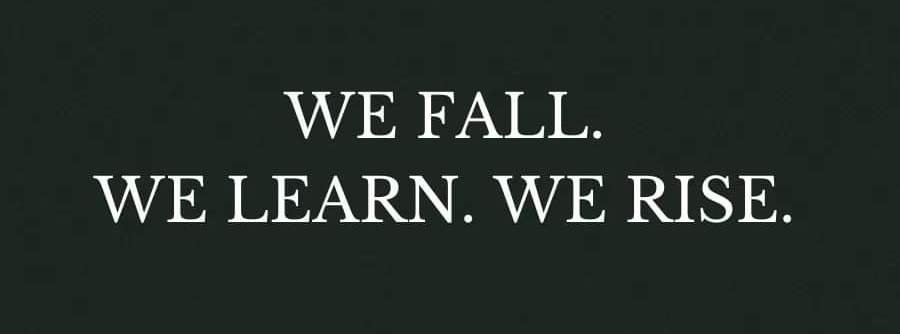Rather than asking yourself what kind of outcome I want to achieve, ask yourself: “Who is the type of person that can do…?”
Start with a small habit, provide evidence of being that kind of person and then eventually you’ll have something to proof this new belief in. Fake it like you’ve made it means to believe in something that you don’t have evidence for, and the word we tend to use for this behaviour is delusion. Rather than letting the belief lead the way, let the behaviour lead the way. Don’t just fake it until you make it, just do the work to make it.
Logo vs. brand
Over the weekend, I explained to my son the difference between a company with a logo and a brand. The example I used showed the difference between a “no-name” hotel and a brand. All hotels have logos and offer accommodation, not all of them have established themselves as distinct brands with a unique identity and reputation. If a “no-name” hotel with a logo came up with a new line of sports shoes, you wouldn’t have any idea of what they would look like. In contrast, a brand like NIKE who has built a strong identity and trust among its customers. If NIKE were to enter a new market like hotels, consumers would have certain expectations about the experience based on their existing perception of the brand.
I think the key message is that brands should focus on creating a strong and authentic identity that resonates with customers over the long term. This identity should extend beyond just a logo or a product line; it should encompass the values, experiences, and trustworthiness associated with the brand. Building this kind of brand equity can lead to greater customer loyalty and a more enduring presence in the market.
The key concepts of trust
Building trust is essential for any brand's success, customers need to have confidence in the brand's products, services, and overall reputation. Trust takes time to establish and is often built through consistent, positive interactions and experiences with the brand. I think to build long-term trust, brands will need to shift their perspective and approach. For example, this could involve moving away from short-term, profit-driven strategies and instead focusing on strategies that prioritise customer satisfaction and loyalty. As authenticity is crucial in today's marketplace and consumers are more inclined to support brands that are genuine and transparent in their actions and messaging. Brands that try to be something they are not or engage in deceptive practices are likely to face backlash from customers.
““Introducing a small character flaw makes you more likable, because people can’t relate to you when you’re just all shiny and perfect.””
Various aspects of life
Life is all about the struggle and challenge to develop ourselves and our skills to see what we can create of value in the marketplace. There is also a social part, a spiritual part as well as the physical part. Personal development is not an easy matter, new habits don’t come easy, but they can be developed. We all have heard the old saying that “Success is 10% inspiration and 90% perspiration.” Therefore, you have to read the books, learn the skills, put yourself through the paces, do the mental press ups and get yourself ready.
Inspiration must lead to discipline as it’s one thing to be motivated, and another thing to be motivated sufficiently to take the classes, do the reading, do the repetition, go through it over and over until it becomes part of you and those are challenges. They are not easy, but they are challenges that if you win, develop and grow that’s what will determine your place, your return (equity) and the work you get from the marketplace.
““Success is neither magical nor mysterious. Success is the natural consequence of consistently applying basic fundamentals.”
”
Meaning and structure
Starting a business is a multifaceted journey that involves bringing a marketable skill, idea, service or product to life, creating value for your target audience, and leveraging your knowledge, abilities, efforts, and time to achieve success. Adaptation, continuous learning, and effective resource management are ongoing processes that contribute to the growth and sustainability of your business. To ensure you have a clear understanding of your business venture, you should consider the following questions:
• What exactly is it that you do?
• Who is your target audience?
• Why does your business matter?
Are you thinking about starting a business? Contact me via e-mail and book a business development strategy meeting.
An age-old issue
Transparency plays a crucial role in sales, and one essential aspect of it involves openly sharing the deals you can provide. This entails demonstrating to your clients the various resources at your disposal, your ability to secure funding, and the potential for discounts. Such openness fosters a sense of partnership, encouraging clients to engage more readily. Additionally, gaining insight into their budget, priorities, and buying processes aligns you more closely with their requirements, thus increasing the likelihood of a fruitful collaboration. I think sales excellence is about building strong relationships with clients and being transparent about your strengths and weaknesses. And by becoming a trusted advisor to your clients, you can create long-term partnerships that benefit both parties. Remember, transparency is not just essential in sales, but in life as well.
Making meaningful changes
Achieving meaningful change is often dependent on having a clear objective, believing in your ability to make that change, and embracing a committed mindset that prioritises rational planning over fleeting emotions. This approach can lead to a more sustainable and effective path to personal growth and transformation. I think that to understand the factors that influence our capacity to change, one needs to consider the following three key elements:
1. It's not solely about the external events or circumstances that occur in our lives but rather how we choose to navigate and respond to them. Developing psychological mindedness involves being attuned to our thoughts, feelings, and reactions, which can significantly impact our ability to initiate change.
2. While motivation can be a fleeting and inconsistent source of drive, commitment provides a more stable foundation for success. By detaching from emotional fluctuations and focusing on a well-thought-out plan of action, we can reduce the reliance on fleeting emotional states. Cognitive dissonance, the discomfort caused by acting against one's beliefs, can serve as a powerful motivator for change.
3. Instead of relying on raw emotion to drive our actions, we can manage our emotions through commitment. By making a conscious decision to pursue our goals and sticking to our plans, we create a sense of commitment that, in turn, generates motivation. This shift from relying on external motivation to fostering internal commitment can be a key factor in achieving lasting change.
Send me an e-mail and let me know what do you think.
Building revenue capacity
The importance of transparency in sales cannot be overstated, regardless of whether you work for a small or large organisation, acknowledging your strengths and weaknesses is crucial. This acknowledgment not only demonstrates honesty but also helps in creating more meaningful connections with your clients. A potent tool for achieving this transparency is a SWOT analysis on both your own business and your competitors, as this comprehensive evaluation allows you to pinpoint gaps in the market that you are uniquely positioned to fill. When reaching out to potential clients, it's essential to maintain this transparency throughout the sales process. Start by openly discussing any previous investments they may have made in your company. This not only showcases your commitment to transparency but also reinforces their trust in your organisation. I think by highlighting the additional benefits and opportunities available to them, you not only demonstrate your dedication to their success but also enhance the perceived value of your products or services.
High-performance metrics
Sales is often associated with closing deals and achieving excellent sales results. However, true sales excellence is not just about hitting numbers, it is about becoming a student of all the variables and parameters involved in the playing field. I think this starts with building relationships and utilising resources, and the ultimate goal should be to become a trusted advisor to your clients. And if this is achieved then deals and sales results will come as a by-product of these relationships. To build strong relationships, honesty and sincerity are essential. Instead of rattling off a list of the great things about your product or service, acknowledge the limitations and show a willingness to learn about the client’s needs and priorities. By doing so, you will stand out from other salespersons, and your authenticity will help build trust with your potential clients.
Adapt and evolve
The Butterfly Effect is all about how small changes in a complex system can equal results that are virtually impossible to predict. What might seem like a very small and insignificant change in one place could result in large differences somewhere else or at a later stage. Having the same metrics and the same incentives and the same bonuses across the board in a business can be detrimental. I think it’s more beneficial to segment and measure various activities differently. One of the drawbacks with uniformly applying efficiency metrics is that it discourages innovation and risk-taking. For example, if the goal is a modest 4.5% annual improvement, individuals may avoid bold initiatives because success poses challenges and failure brings its own set of problems. Therefore, I think it’s essential to establish distinct metrics and incentives for various marketing activities as there are the things where very small changes make very, very big differences.
NB. The complexity theory recognises that economic and organisational phenomena are similar to those observed in science and in nature.
Taking risks
Effective communication is crucial for leaders as it enables them to convey their vision, goals, and expectations clearly while also actively listening to their team. Leaders who consistently champion creativity foster innovative thinking and problem-solving among their team members, thereby nurturing trust and reliability within the group. In addition to this, a crucial leadership skill involves the adept management and resolution of conflicts within the team. I think understanding and respecting diverse cultures and perspectives is also important, especially in diverse teams or global organisations.
Gathering information
Typically, our sales process entails a sequence of critical milestones. These milestones include gaining a comprehensive insight into the client's internal buying procedures, acquiring a clear understanding of the legal review process, and identifying key stakeholders while understanding their individual and business objectives and motivations. In order to navigate the inherently non-linear nature of this process, we approach sales and buying as a series of commitments we establish with our clients. This involves phases such as initial discovery, examining potential solutions, involving additional stakeholders, further discovery, comprehensive discussions, reaching mutual agreement on the investment, bringing in more stakeholders, managing conflicts, fostering collaboration, and refining the solution. I think at times, it may appear as if we are starting from scratch, despite being in close proximity to the finish line.
A little reminder
I think that failing to assertively say "No" or set clear boundaries can lead to numerous problems. It's essential to recognise that lacking these boundaries can be quite costly. Rather than resorting to lies or excuses, it's important not to fear disappointing individuals who only seem to remember you when they need something. Instead, choose to decline their requests immediately. Remember, while empathy is valuable, it should be accompanied by well-defined boundaries to avoid self-destructive consequences.
““You can cut all the flowers but you can’t stop Spring from coming.””
Aspirational choices
Businesses tend to become less risk-averse when they are confronted with a crisis, as the saying goes, 'necessity is the mother of invention.' Consumers also develop a narrative explaining why they are adopting new behaviours. Periods of disruption, although they introduce variance and instability in the economy, can potentially be healthy in the long-term. I think that the obstacles to technology adoption primarily stem from psychological hurdles, and this is why I find marketing fascinating, as it poses the challenge of converting people in the first place.
““When you have to make a choice and don’t make it, that is in itself a choice.””
Race had nothing to do with my decision
Unconscious bias (also referred to as implicit bias) is the process of associating stereotypes or attitudes towards categories of people without conscious awareness – which can result in actions and decisions that are at odds with one’s conscious beliefs about fairness and equality. I think this can lead us to make biased and unfair decisions regarding who we hire for a job or select for a promotion, which classes we place students into and who we send out of the classroom for behaviour infractions, and which treatment options we make available to patients. And, we know from extensive research, that this happens all the time in our schools, in hospitals, in policing, and in places of employment.
Embracing the concept of anti-fragility
Are you familiar with Nassim Taleb’s “Barbell Strategy”?
Yes, the Barbell Strategy is a concept Nassim Taleb introduced in his book "Antifragile: Things That Gain From Disorder," which is designed to help individuals and organisations navigate uncertainty and volatility. Taleb suggests that in situations of high uncertainty and unpredictability, it's best to avoid the middle. This means staying away from investments or strategies that have moderate risk but limited upside, as they can be vulnerable to unexpected events. Taleb’s says we should put 80% into less risk, low reward investments to ensure that you don’t go bankrupt, and then put a small percentage into things where you have a finite knowable downside and where the potential upside can be huge. I think it’s essential you look at them differently, the way you react when you lose money in 20% range should be with “it could happen” eyes. On the other hand, if you lose money in the 80% bracket you should panic, as this investment is not supposed to be losing you money.
A large part of business is about being totally logical, consistent, pursuing efficiency, exploiting what you already know, following best practice, etc., etc. I think the Barbell Strategy can be applied to financial investments as well as to various aspects of life, including career choices, personal health, and decision-making. It's a way to thrive in a world where uncertainty and randomness play significant roles.
Balance is a concern
Sales is a series of asking for commitments and all salespersons - regardless of who you are or what you are selling – have two primary concerns:
1. RESULTS
- Did you make the sale?
- Did you bring in the money for your company?
- Will you receive your commission?
Everyone ultimately wants to achieve tangible results.
2. RELATIONSHIPS
- Did your client enjoy the selling process?
- Do they now know, like and trust you?
- Did they enjoy your selling process enough to speak positively about you and your company by giving you a referral?
I think the balance between achieving results and nurturing relationships with clients is essential for successful salespersons. Contact me via e-mail for sales training and workshops.
Learn how to deal with no
Human beings fear two things more than anything else in the world: death and rejection. And research has shown that people fear rejection more than death, this is because we are biologically and historically wired to avoid getting thrown out of the tribe, so we do everything in our power to net get rejected. I think we have to change our interpretation of rejection as our brains are always trying to interpret everything – What does this mean and how can I protect you? Unfortunately, the brain is not always our best friend, so we have to learn how to reframe the stories we tell ourselves. Contact me via e-mail for sales training and workshops.
““Asking is the beginning of receiving. Ask the question, receive the answer. If you don’t ask, you don’t get.” ”
Breaking promises
The size of the commitments we keep to ourselves correlates to the size of the rewards we receive at the other end. For example, if we keep big commitments to ourselves their influence on our self-esteem and the narrative we tell ourselves can be used as evidence about who we really are. Conversely, I think if you break small promises to yourself then you’ll sow the seeds of doubt and weaken your resolve when it come to the larger ones.
Ask questions
Arrogance pretends it knows, whereas humility shows up to learn. I think we all desire knowledge and seek to avoid appearing ignorant, ultimately transforming learners into knowledgeable individuals by showing up to learn rather than pretending to know it all.
Why is it important to test assumptions?
Can you give me an example of a situation where testing assumptions led to a positive outcome?
What are some common barriers to exploring different options?
How do you personally challenge yourself to grow and develop?
In what contexts do you find it challenging to listen deeply, and how can you overcome those challenges?
What has been a significant change you've made in your life, and what motivated it?
Can you explain the concept of feedback loops and their significance in various scenarios?
How do you go about seeking input from others, and why is it valuable?
Please send me your answers via e-mail.
I will give free 45 minute 1:1 consultation to everyone who replies before midnight on Sunday (17th September 2023).





















